


8th Battalion, 20th Engineers
The Eighth Battalion
Note: Most of the text of this article comes from "TWENTIETH ENGINEERS -- FRANCE -- 1917-1918- 1919"
Organization of the Eighth Battalion was commenced January 20th, 1918, replacing in training - quarters the Sixth who left Washington January 22nd for their ill starred voyage on the "Tuscania." Recruiting brought the Eighth to strength in a few weeks, but recurrent outbreaks of mumps, measles and scarlet fever made constant replacements necessary, most of them them being drawn from the Tenth Battalion, which was just then serving as a Depot organization. Just before leaving American University Camp about 60 replacements were drawn from the Tenth, so that the Eighth was but loosely organized for France.
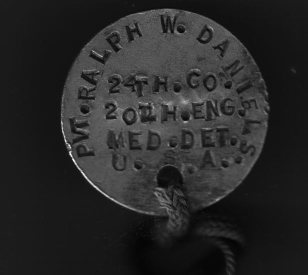
One of the "dog tags" belonging to Private Ralph W. Daniels, assigned to the Medical Detachment, 24th Company (previously Company F, 8th Battalion), 20th Engineers. The dogtags were aluminum, with information crudely stamped into the metal. A woven cord of cotton was used to hang the identification around the soldier's neck.
The Battalion left Washington February 25th, 1918, with 22 officers and 797 men, and boarded U. S. S. "Mount Vernon," formerly the German liner "Kronprincessin Cecilie" the next day. February 27th they sailed for France, arriving after an uneventful voyage at Brest, March 10th. The following day they disembarked and marched to Pontanezan Barracks, which had previously housed our Third, Fourth and Fifth Battalions.
After four days of rest and drill the outfit was split into its component parts. Battalion headquarters and Co. D were sent to their assigned districts in the Loire Valley; Co. E to the Landes, far to the south, and F to the Swiss border. Unlike most of the Forestry units, the companies were never re-united, and the Battalion, as a military organization, ceased to exist except on paper.

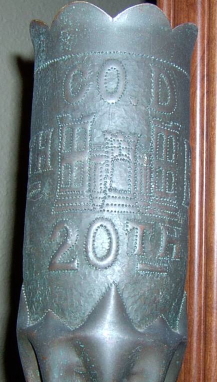
This is a brass artillery shell that has been reclaimed for use by a soldier to create a piece of art. There are many such examples from the war. This shell has been fluted. Imagery from the shell show the engineer castle and the soldier's unit--Company D, 8th Battalion, 20th Engineer Regiment. The unit's patch, that of the Advance Sector, is also on the shell. Click on the picture for additional photos of the shell.
Co. D, later renamed the 22nd Co., left Brest with the Headquarters Detachment, and proceeded to their assigned station, La Mallardais, near the town of Le Gavre, in the lower valley of the Loire. For four days the outfit assimilated the climate, billeting in pup tents on an oozy field. With the arrival of the engineering equipment, construction was started on a mill of 10,000 capacity, and logging commenced with horses and tractors. Headquarters was removed to Bauge, in which a new district organization was established, including the operations at Le Gavre, Rennes, Marchenoir, and several smaller camps.
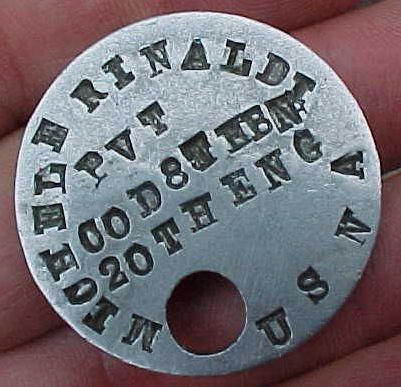
Dogtag for Private Michel E Rinaldi, Company D, 8th Battalion
May 3rd a force of 100 men of the 22nd Co. were detached for duty with Co. A of the Tenth Engineers; 50 were sent to Chambord, Loir-et-Cher, and the rest to Lambel-Camors, Morbihan. The Le Gavre camp was retained, and the mill operated, until after the Armistice, the only important changes in the Co. personnel being the dispatch of 60 mechanics to the Epinal District, where they became a part of the Forestry unit attached to the First Army, operating in the St. Mihiel and Argonne areas.
Sawing was completed at Le Gavre December 22nd, 1918; four weeks later the 22nd Co. moved to the camp of the 23rd Co. (D of the Fourth Battalion), at Marchenoir, where homecoming preparations were commenced. As with every other Forestry outfit, these plans were spurles versenkt, and the 22nd were ordered to Blois for road work.
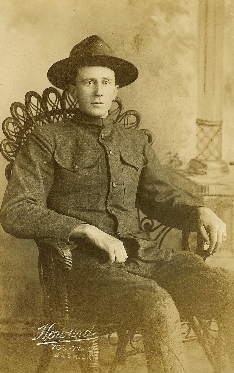
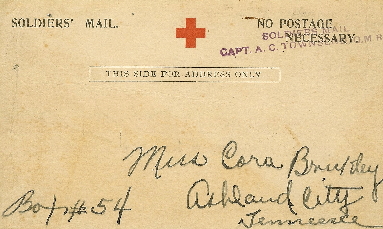
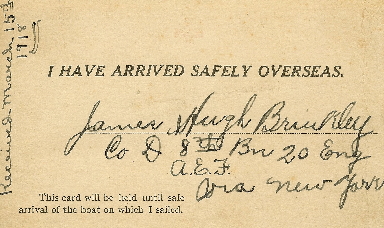
Photo and "Arrival" postcard of James Hugh Brinkley, Company D, 8th Battalion, 20th Engineers
Courtesy of his grandchild, Kim Daniell
February 8th the unit commenced work on five hundred kilometers of highway, with a set of stone crushers and 500 German prisoners as the principal equipment. After completing 300 miles of metalled road, half the Co. were ordered to Paris to complete the construction of the ''Pershing Stadium,'' which had been started by French civilian labor. The civilian force had struck for better terms, and the job was completed by American troops, most of whom, under the priority plans of the Secretary of War, were overdue at Hoboken.
The 22nd was reunited early in June, and sent to LeMans, whence they proceeded to St. Nazaire June 13th. Two days later they sailed for home on the transport ''Texan,'' and arrived at Newport News June 29th, 1919. There the outfit was dissolved.

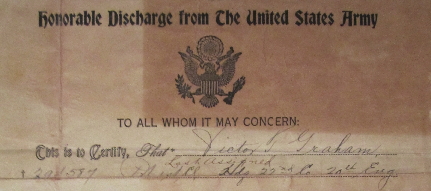
See the enlistment record and discharge papers of Victor Graham, 22nd Company
(courtesy of great- grandson Sergeant Marcus Lawton, himself a veteran of the Iraq War in 2011)
To take over part of the burden placed upon the earlier Forestry troops in the Landes, Co. E was ordered south from Brest. A three day trip down the Biscay coast, through Brittany, Vendee, and Gascony, brought them to Labouheyre, a railroad center in the heart of the pine woods. The unit was here divided, half the Company going eastward to Mont-de-Marsan, the remainder, with the company organization, joining their lot with the Fourth Battalion in the coastal dune region.
The latter detachment made camp in March in the center of one of the largest unpeopled tracts in France, on the once-a-week railway, 8 miles north of district headquarters at Mimizan-les-Bains, and but two miles from the shores of Biscay. The ubiquitous French forester who patrolled the region assigned the name Pendell to the new settlement, though where he got the name remained one of the unsolved mysteries of the War.
The detachment erected an American mill of 10,000 rated capacity, and logged a difficult area of maritime pine. The operation called for extensive narrow gauge railway development, the yielding character of the unprotected sands made skidding, trucking or wheeling impracticable.
In common with the other units of the Mimizan district Co. E. now the 10th Co., struggled through a memorable summer. The intense heat of the Midi, aggravated by insufficient food, and punctuated with a disastrous visit of the flu in August was a severe test of morale. The advent of fall weather was no where more eagerly welcomed, if only for the restoration of the long forbidden privilege of smoking on the job.
The other detachment of the 10th Co. was assigned an operation near the Department capital, Mont-de-Marsan, within the Dax (First Battalion) control. They also worked in maritime pine timber, but of a less gnarled and windswept nature, and on firmer ground ground than the quartz sand dunes of the Mimizan neighborhood.
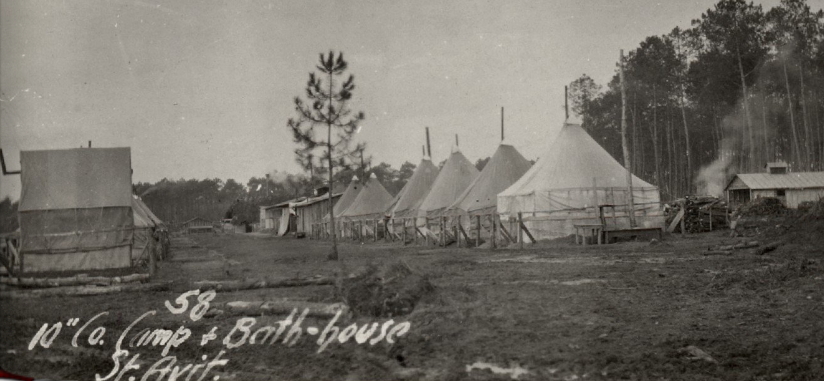
The camp of a detachment of 10th Company at St Avrit, in the Dax District
Note the bath-house at the left of the image
After the Armistice the company wound up their affairs and moved mills and barracks bags to the Pontenx Burnt Area, where in January, 1919, they became units in the great cleanup undertaken on the hypothesis that "Lafayette, we are still here." Four weary, muddy months brought the big job to completion and the 10th Co., now attached to the Tenth Battalion organization, prepared for a change of scene.
After undergoing the usual ordeals, the outfit boarded the transport, "K. I. Luchenbach," in company with most of their fellows of the Burnt Area, May 16th. The crossing was made at the freighter's speed; Hoboken finally received her due June 1st. The unit was ferried to Alpine Landing, on the Hudson, and hiked to Camp Mills, where the war was officially found to be over.
Co. F. having left Brest in the accept 40-Hommes fashion March 11th, traveled eastward and upward for three days and nights, finally reaching the border Department of Doubs, in the Alsatian Alps. The Co. detrained at the village of Etalons, from which, four days later, half the unit detached themselves and pushed on for the hamlet of Maison du Bois, where they made permanent camp. This detachment held the distinction of being the nearest American unit to neutral soil, the camp being less than two miles from the Swiss boundary.
The locality was highly attractive, abounding in natural beauty of flowers and trees, at an elevation of 3000 feet. Both halves of the company held their original stations through the summer and winter of 1918, conducting their mill and woods operations until orders came to prepare for home and mother.
The first westward move was made April 28th, when the Maison detachment returned to Etalons. The reunited Company drilled and waited until May 21st, when they crowded into trucks, ambulances and jitneys and started for America overland. Passing through A. E. F. Headquarters at Chaumont, they brought up at Rimincourt, pushing on to Le Mans four days later.
June 1st
the outfit route marched to Laigne for a week of final preparations. On
the 10th the last stage of French journeyings was covered, and five
days later the Company sailed from St. Nazaire aboard U. S. S.
"Tiger.'' Sixteen months to a day since leaving the shores of
America the 24th Co. landed at New York. July 1st saw the final
dissolution of the organization.